International Students Studying in the United States: Trends and Impacts
A Boundless report uses public data to examine how international student enrollment has changed over time
Not only has the United States been built on immigration, but it is continually strengthened economically and culturally by its vast international population. A key part of sustaining this diversity involves supporting, investing in, and welcoming international students to college campuses. The United States has historically been a top destination for students, driven by opportunities for research, professional advancement, and sociocultural engagement. Particularly in the last few years, the experiences of international students in the US have become a microcosm of changing rhetoric toward immigrants, the effects of the COVID-19 pandemic, and perceptions of the United States on a global stage.
By examining data on the contributions of international students in the United States and related trends, we can more clearly understand the power and benefits of having this unique community, and what its future might look like.
A Look at International Students in the U.S.
The Student and Exchange Visitor Program (SEVP), administered under an umbrella of agencies including DHS and its sub-agency U.S. Immigration and Customs Enforcement (ICE), identifies international students as “nonimmigrants”— that is, any foreign national who temporarily visits the United States to fulfill a specific purpose, such as business, or, in this case, study.
Nonimmigrant students are eligible for the following visas:
- F-1: Those who seek to complete an academic course of study to complete K-12 or a college degree at an SEVP-certified school or program;
- M-1: Those whose primary purpose is to complete a vocational course of study at an SEVP-certified school or program;
- J-1 (exchange visitors): Those selected to participate in a U.S. Department of State-designated exchange visitor program.
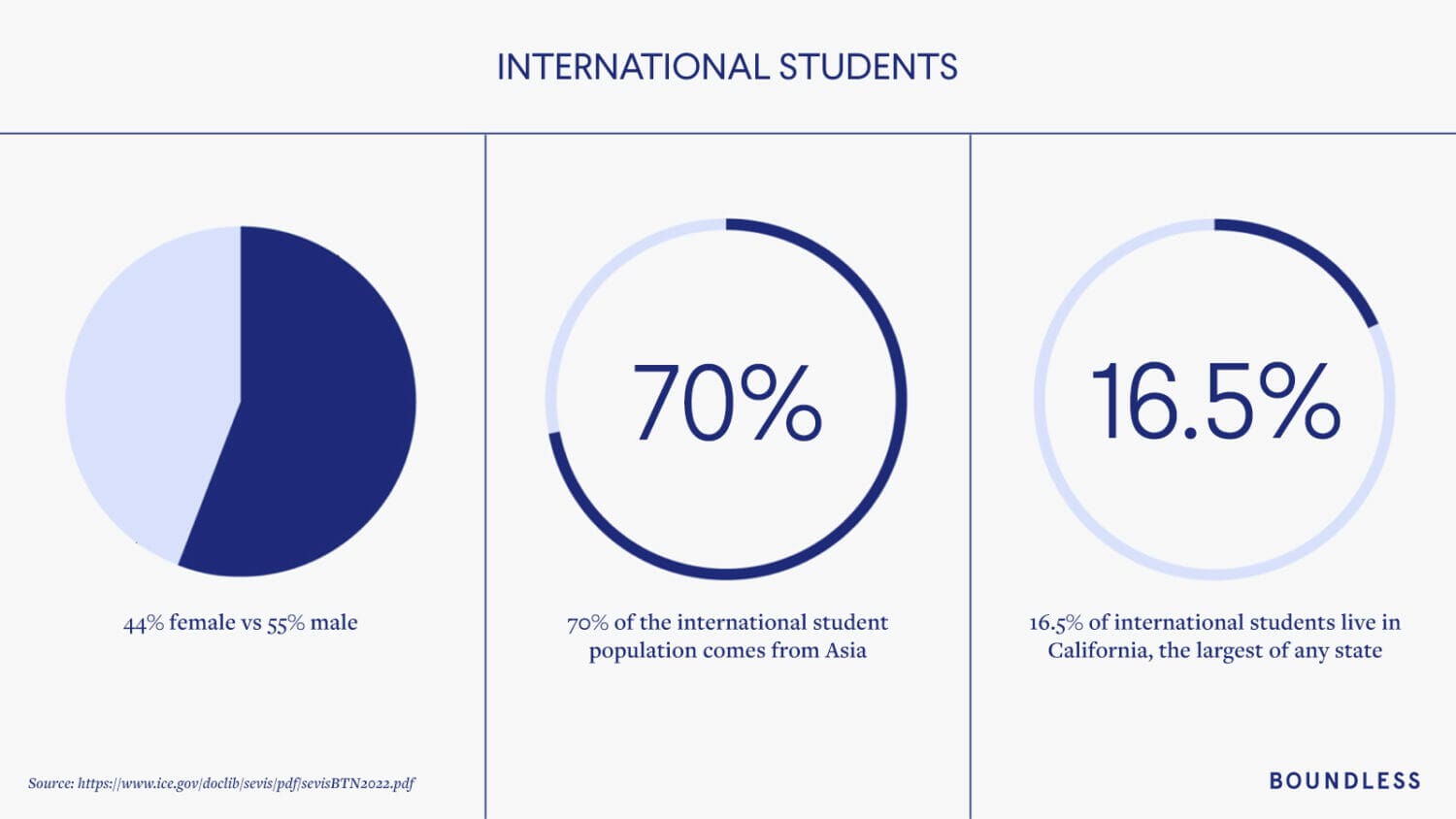
International student mobility refers to the enrollment of international students in proportion to the total number of students in the given host country. In the United States, there are more than a million enrolled international students, making up nearly 6% of the total student body in the country, despite a slight decrease during the COVID-19 pandemic.
In 2022, international students in the United States came from more than 227 countries and represented every continent in the world, with the exception of Antarctica. Due to the large number of students coming from China and India, more than 70% of international students in the U.S. come from Asia. All six continents saw an increase in the number of students coming to the United States. However, despite China still being the number one country of origin, China sent fewer students to U.S. schools in 2022 compared to 2021, highlighting a recent trend of Chinese students looking elsewhere to reach their education goals. Various roadblocks in recent years such as visa delays, unfriendly immigration policies, and growing global competition have redirected prospective Chinese students to opportunities in other countries. Universities in Canada, Singapore, and the U.K. have all seen an increase in Chinese students over the past several years, when compared to the U.S.
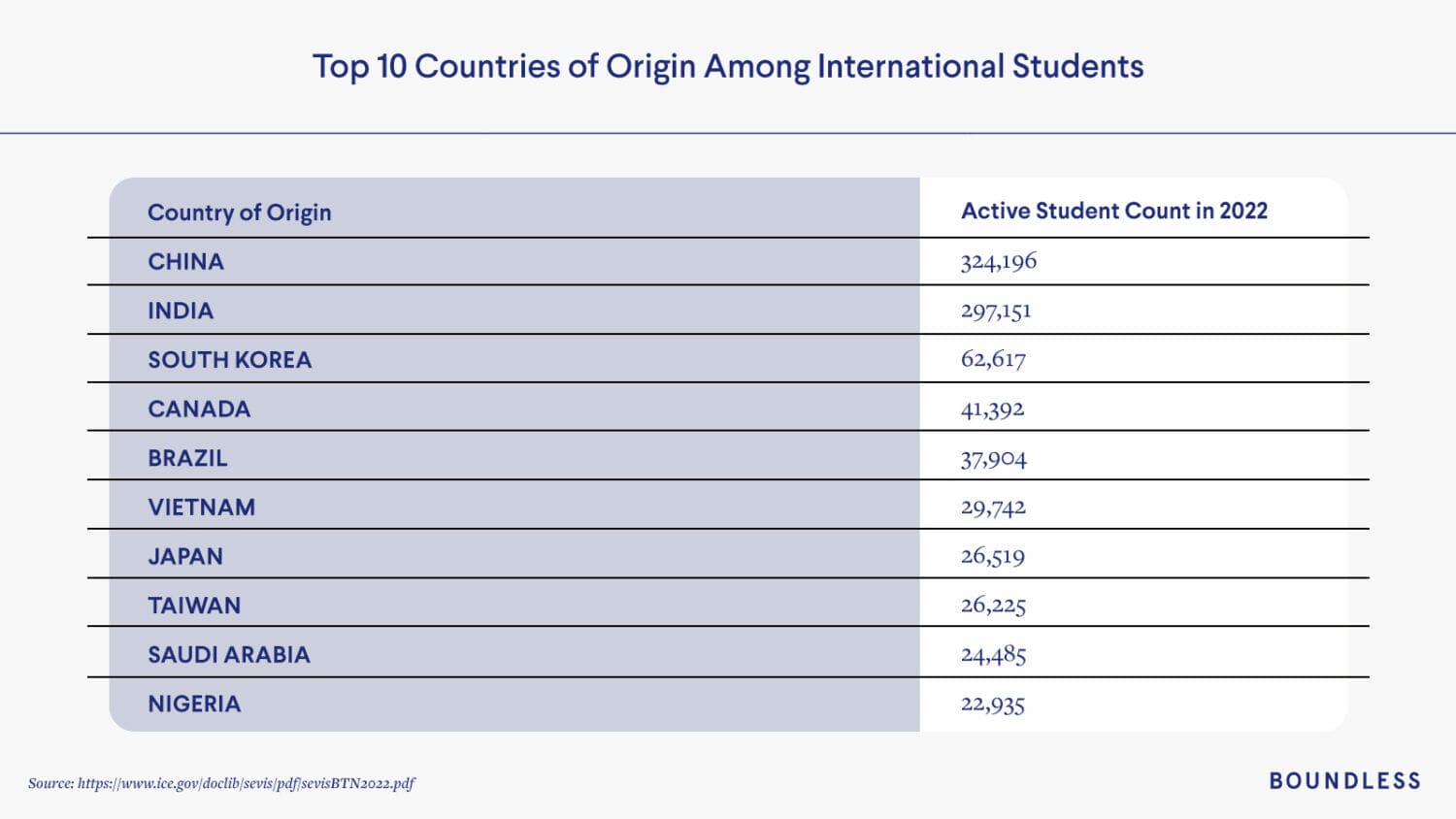
In May 2021, Duolingo published a report that examined 2020 international education trends based on the number of students sharing their English proficiency results to programs around the world. The list of top-sharing countries included the debut of Kyrgyzstan and Nigeria.
Historically, these countries have not been top countries of origin for students entering higher education in the United States. Per Duolingo, this trend signals that significant numbers of students from wider geographic regions are seeking international higher education opportunities—perhaps benefitting from the increased accessibility of affordable, online proficiency exams like Duolingo’s English Test.
Top Areas of Study for International Students
Most international students come to the United States to enroll in higher education — specifically, SEVP-certified associate, bachelor’s, master’s, or doctoral programs. Most students pursue degrees in STEM fields (science, technology, engineering and math), as well as business and management. In the 2021-2022 academic year, the 10 most popular fields of study, based on a student’s primary major, were:
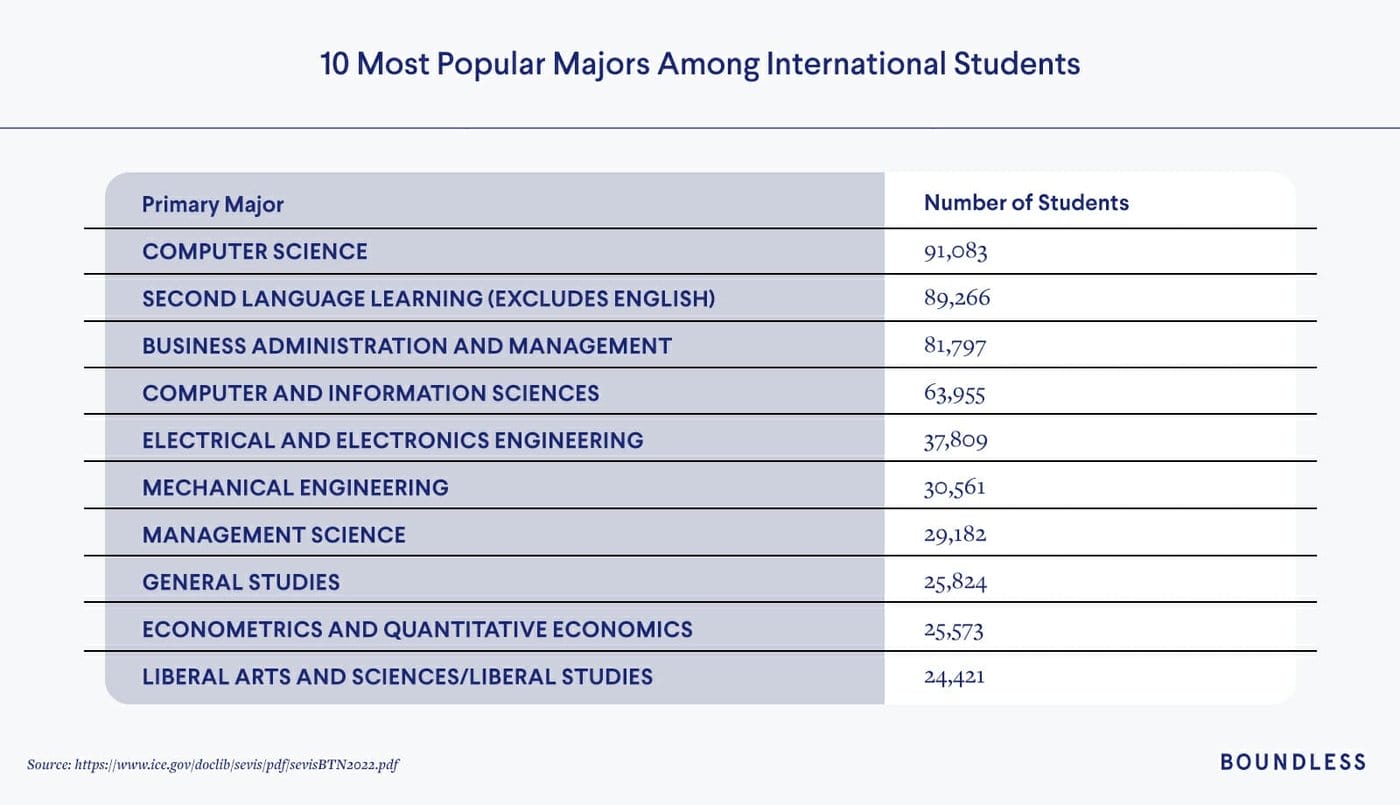
Top states where international students live
International students are enrolled in schools and live on/around campuses across the United States, but nearly half of all international students study in just these 5 states: California, New York, Texas, Massachusetts and Florida.
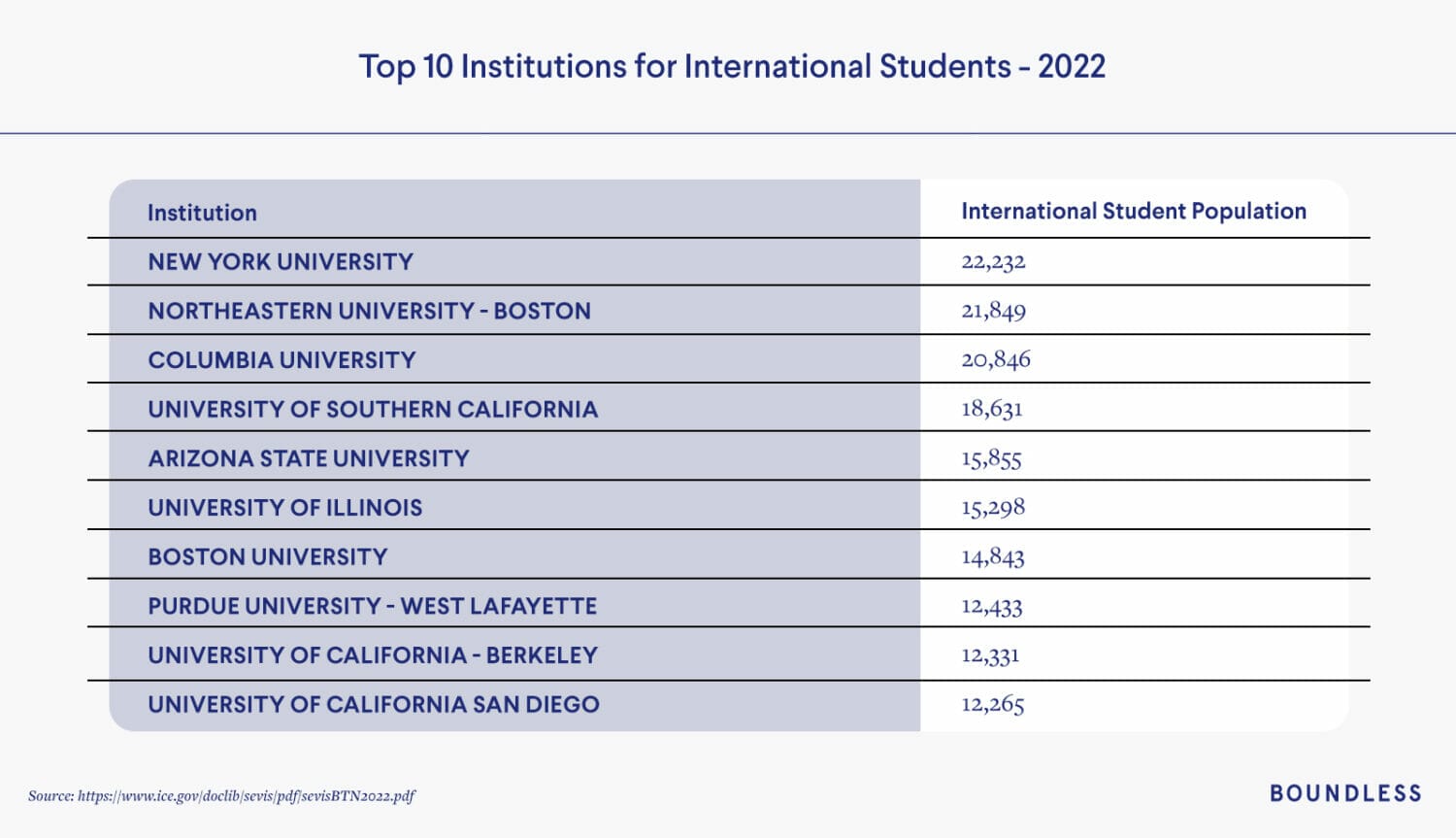
Top states where international students live
International students are enrolled in schools and live on/around campuses across the United States, but nearly half of all international students study in just these 5 states: California, New York, Texas, Massachusetts and Florida.
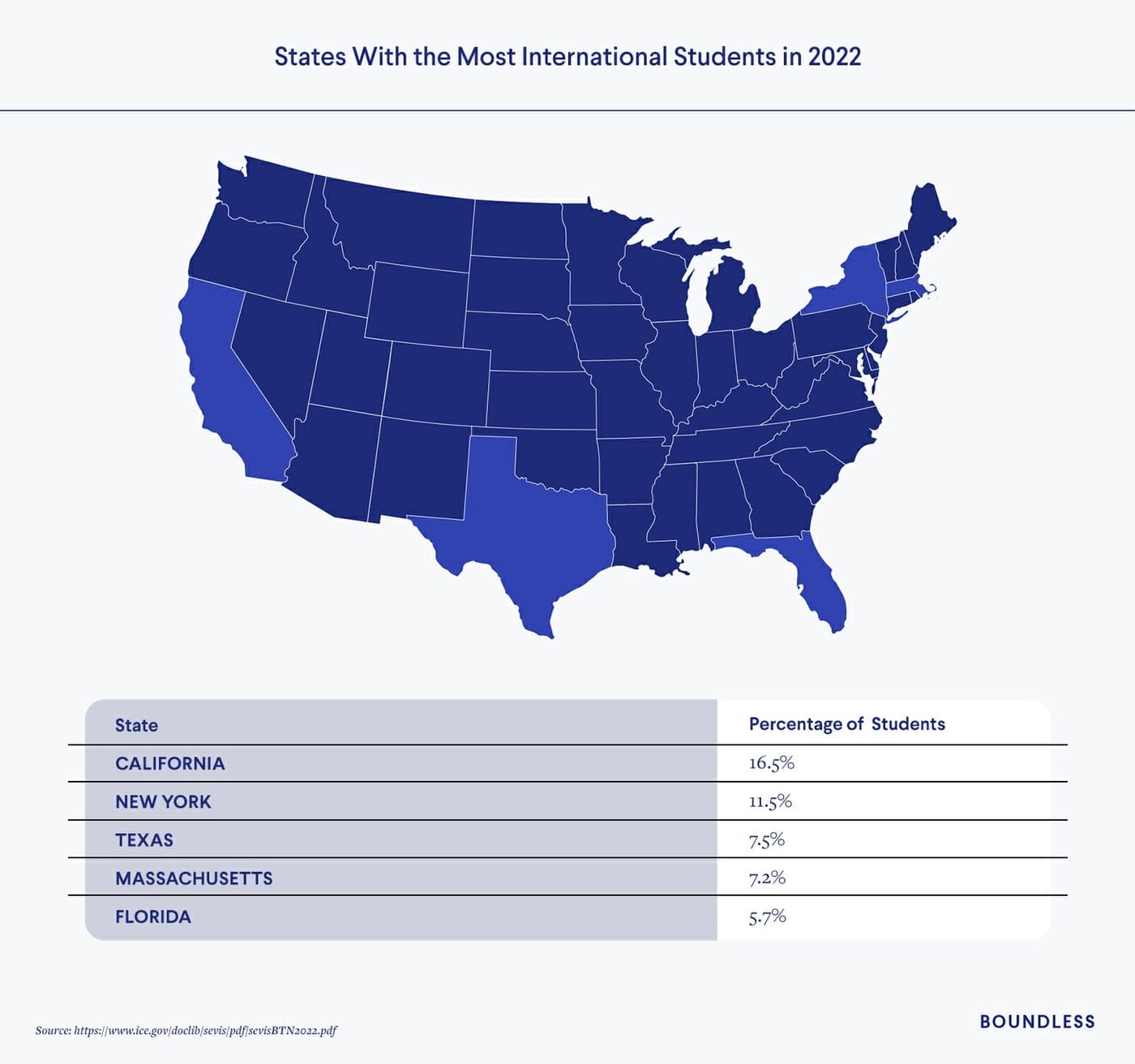
Contributions of International Students in the U.S.
Having so many international students on U.S. college campuses has an immediate economic impact. For one, international students usually pay higher tuition than domestic students in public universities because they do not qualify for state residency tuition breaks (private schools generally do not charge different tuition fees for U.S. and foreign-born students, though tuition at private institutions is generally higher than public colleges and universities). During the 2021-2022 academic year, they contributed $33.8 billion to the U.S. economy and supported more than 335,423 jobs. Despite these numbers, this marked a decrease of more than a third from the previous year.
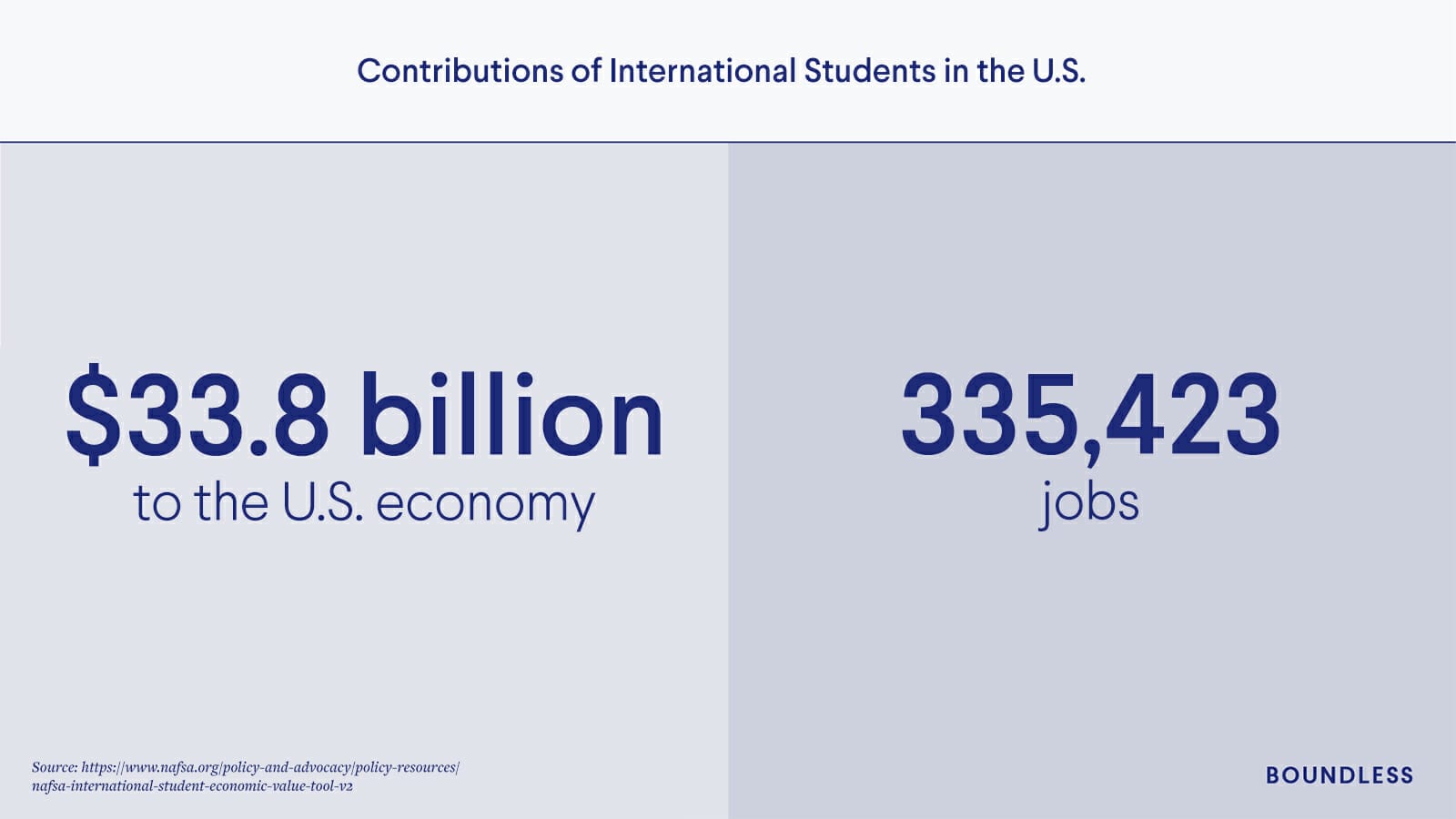
But international students stimulate more than just the economy; they also enhance the intellectual and cultural environment for American students. The relationships and experiences shared by domestic and foreign students have long-lasting impacts on personal, socioeconomic, and even political growth.
Researchers at Duke University surveyed alumni from several universities roughly 5, 10, and 20 years after graduation. The study found that U.S. students who actively interacted with international students reported better self-confidence, leadership, quantitative skills, and overall intellectual growth. Later in life, participants were more likely to appreciate art and literature, be able to place current problems in historical context, read or speak a foreign language, reexamine their political and religious beliefs, and reassess their beliefs about other races or ethnicities.
“A larger number of international students on campus could provide more opportunities for domestic students to interact across cultures and challenge their existing belief and value systems,” the researchers wrote.
According to findings in 2019 by the UK-based Higher Education Policy Institute (HEPI), the United States is the most popular place of study for overseas students who go on to become political leaders in their home countries. This is significant because research has found that when international students develop positive relationships with their host countries, they are more likely to have future visits, do business and maintain fruitful relationships with that country.
HEPI researchers write: “Growth in the number of people crossing borders for higher education has been so strong in recent years that any country that is not increasing its numbers significantly is falling back against its competitors in terms of global share.”
Changes in International Student Enrollment Over Time
First, the obvious: the COVID-19 pandemic had a marked impact on international student enrollment, but 2022 showed strong signs that enrollments were rebounding.
According to the SEVP, there were nearly 1.4 million active records for F-1 and M-1 students in 2022 — a 10% increase from 2021 and the largest number of records since 2019. All four regions of the U.S. – the Northeast, Midwest, South, and West – saw an increase in international student records of between 8% and 11%. The Northeast saw the greatest increase at 11.6%, closely followed by the Midwest, which welcomed 11.5% more international students.
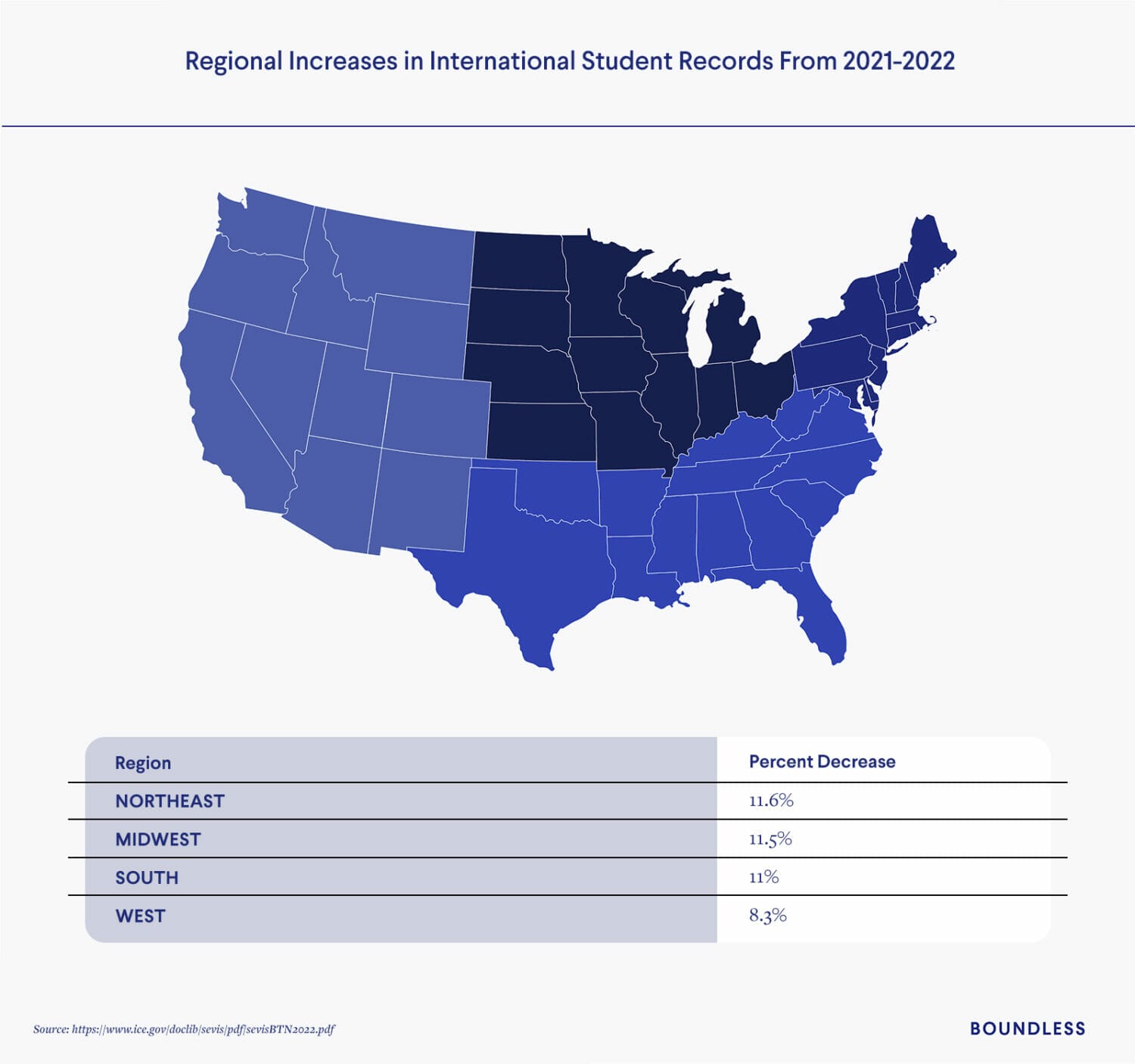
This trend was true across all degree programs in the 2021-2022 school year, with Master’s programs experiencing the largest increase (15.7%).
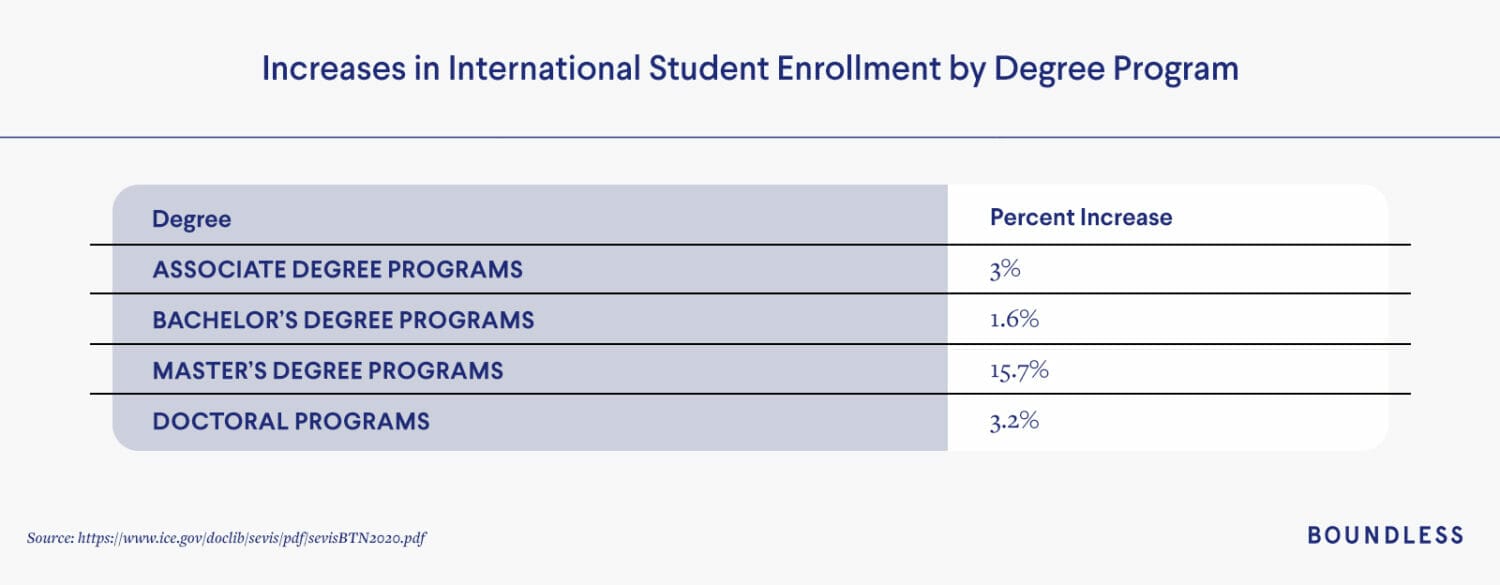
WHY More INTERNATIONAL STUDENTS ARE STUDYING IN THE UNITED STATES
After a drop in international student enrollments during the COVID-19 pandemic, enrollments are rising. Possible reasons for the increase include:
- End of COVID-19: The coronavirus pandemic brought travel to a virtual standstill. Now that travel restrictions have been lifted across the globe, U.S. campuses are thrumming with life once again. According to a 2021 survey by the Council of Graduate Schools, which looked specifically at masters and doctoral programs, the sharp drop-off in international enrollment from fall 2019 to fall 2020 was fueled more by health and travel issues than a drop in interest.
- Friendlier legal immigration policies: In 2020, researchers from Central Michigan University examined “the Trump effect”—the net effect of the Trump administration’s policies, anti-immigrant rhetoric, and shifting requirements for both students and colleges. Although international student enrollment was already declining prior to Donald Trump taking office, new international student enrollment decreased by 6.6% in the 2017-2018 academic year and 0.9% in the 2018-2019 academic year. While Biden has been slammed for his border policies, he has undone many of Trump’s most restrictive immigration policies.
- Increased outreach: According to a 2022 survey by the Institute of International Education (IIE), colleges and universities attributed their growth in international student enrollment to active outreach and recruitment efforts as well as increased visibility of their institutions. The top countries of outreach were India, Vietnam, China, and South Korea.
One of the benefits of traveling is being granted the opportunity to experience people, cultures, and belief systems outside of our own — and citizens also benefit when international visitors uproot their lives to work and study in a new country.
There is plenty of evidence for how international students enrich the United States, both economically as well as in making its citizens more globally aware and culturally competent. This in turn could lead to higher levels of international cooperation and peace-building, cultivating a sustainable future for not just this country but the planet as a whole. When we interact with people who broaden and challenge our perspectives, we become more global-minded, more connected, and more culturally competent. In this way, international students are a key part of not just U.S. campus life, but also United States culture as a whole.
About the Data
The following public sources were used:
- Hanson, M. (2021) “International Student Enrollment Statistics.” EducationData.org. Retrieved from: https://educationdata.org/international-student-enrollment-statistics/
- Hillman, N., & Huxley, T. “The soft-power benefits of educating the world’s leaders,” HEPI Policy Note 16, Higher Education Policy Institute. Retrieved from: https://www.hepi.ac.uk/wp-content/uploads/2019/09/Policy-Note-16-_-The-soft-power-benefits-of-educating-the-world%E2%80%99s-leaders-05_09_19-Screen.pdf
- Institute of International Education. (2021). “COVID-19 Effects on U.S. Higher Education Campuses.” Retrieved from: https://www.iie.org/en/Connect/COVID-19/COVID-19-Snapshot-Survey-Series
- Institute of International Education. (2022). “Fall 2022 International Student Enrollment Snapshot Survey.” Retrieved from: https://www.iie.org/wp-content/uploads/2022/12/FallSnapshot_2022_FullReport.pdf
- Luo, J., & Jamieson-Drake, D. (2013). “Examining the Educational Benefits of Interacting with International Students.” Journal of International Students, 3(2), 85–101. https://doi.org/10.32674/jis.v3i2.503
- NAFSA. “NAFSA International Student Economic Value Tool.” Retrieved from: https://www.nafsa.org/policy-and-advocacy/policy-resources/nafsa-international-student-economic-value-tool-v2
- Pavic, M., & Dewar, J. “International education trends via the world’s most accessible English test,” Duolingo. Retrieved from: https://blog.duolingo.com/international-education-trends-via-the-worlds-most-accessible-english-test/
- Student and Exchange Visitor Program. (2022). “2022 SEVIS by the Numbers Report.” Retrieved from: https://www.ice.gov/doclib/sevis/pdf/sevisBTN2022.pdf